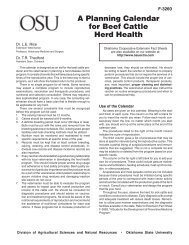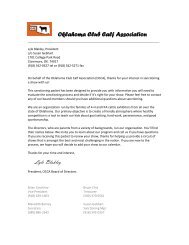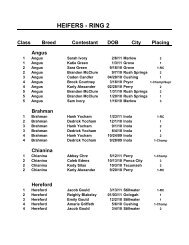Basics About Beef - the Oklahoma Club Calf Association
Basics About Beef - the Oklahoma Club Calf Association
Basics About Beef - the Oklahoma Club Calf Association
You also want an ePaper? Increase the reach of your titles
YUMPU automatically turns print PDFs into web optimized ePapers that Google loves.
14<br />
KEEPING BEEF SAFE<br />
Most cases of foodborne illness that are<br />
reported in <strong>the</strong> U.S. every year can be traced to<br />
poor handling, storage or preparation at home<br />
or in foodservice establishments.<br />
The key is to control conditions that give bacteria<br />
opportunities to get into food, grow and/or<br />
survive during <strong>the</strong> food preparation process.<br />
STEAKS AND ROASTS<br />
Bacteria are part of <strong>the</strong> environment and<br />
may exist wherever food is present. Not all<br />
of <strong>the</strong>se bacteria are harmful. If a cut of<br />
meat contains any harmful bacteria, <strong>the</strong>y<br />
will exist on <strong>the</strong> surface. Cooking steaks<br />
and roasts to medium rare doneness<br />
will destroy surface bacteria. Medium rare<br />
steaks and roasts will have a final internal<br />
temperature of 145°F, and <strong>the</strong> interior<br />
will be rosy pink.<br />
GROUND MEAT<br />
When raw meat or poultry is ground,<br />
harmful bacteria that might exist on <strong>the</strong><br />
surface are mixed throughout <strong>the</strong> meat.<br />
Therefore, it is important to thoroughly<br />
cook both <strong>the</strong> inside and outside of ground<br />
meat or poultry patties. Cook ground beef<br />
to medium (160°F) doneness and ground<br />
poultry to 165°F. If an instant-read<br />
<strong>the</strong>rmometer is not available, check to<br />
be sure <strong>the</strong> center is not pink and juices<br />
show no pink color. Never eat raw or<br />
undercooked ground meat or poultry.<br />
In <strong>the</strong> case of meatloaf, always use a meat<br />
<strong>the</strong>rmometer because <strong>the</strong> color can be<br />
deceiving. Vegetables, such as onions, celery<br />
and peppers added to ground beef can cause<br />
<strong>the</strong> meat to remain pink even after <strong>the</strong> internal<br />
temperature of 160°F is reached. Also, sauces<br />
that are brown (such as soy sauce, teriyaki or<br />
worcestershire) can change <strong>the</strong> color of <strong>the</strong> beef,<br />
making it hard to tell when <strong>the</strong> meat is done.<br />
Brush <strong>the</strong> sauce onto <strong>the</strong> surface of <strong>the</strong> beef after<br />
it is cooked, ra<strong>the</strong>r than mixing it<br />
into raw beef.<br />
Safe Handling Instructions<br />
This product was prepared from inspected and passed meat and/<br />
or poultry. Some food products may contain bacteria that could<br />
cause illness if <strong>the</strong> product is mishandled or cooked improperly.<br />
For your protection, follow <strong>the</strong>se safe handling instructions.<br />
Keep refrigerated or frozen.<br />
Thaw in refrigerator or microwave.<br />
Keep raw meat and poultry separate from o<strong>the</strong>r foods.<br />
Wash working surfaces (including cutting boards),<br />
utensils, and hands after touching raw meat or poultry.<br />
Cook thoroughly.<br />
Keep hot foods hot. Refrigerate leftovers<br />
immediately or discard.<br />
Thoroughly Cooked<br />
The food industry, from farm to table, has followed<br />
strict rules to help ensure safe and wholesome food.<br />
However, new procedures and safeguards continue<br />
to be put into place. One such safeguard is <strong>the</strong> safe<br />
handling label on raw meat and poultry. This label<br />
gives basic guidelines for keeping food safe.<br />
SAFE FOOD HANDLING TIPS<br />
Follow this checklist to help keep food safe.<br />
Plan to make beef <strong>the</strong> last purchase before<br />
returning home.<br />
When shopping, put meat in plastic bags to<br />
keep packages from dripping onto o<strong>the</strong>r foods<br />
in your cart.<br />
Wash hands with hot soapy water before<br />
preparing food and after handling raw meat,<br />
poultry or fish.<br />
Use hot soapy water to wash surfaces and utensils<br />
immediately after preparing meat, fish, poultry,<br />
or unwashed fruits and vegetables.<br />
Use separate cutting boards, platters, trays and<br />
utensils for cooked and raw foods. Do not put<br />
cooked food on a platter which held raw food<br />
without washing <strong>the</strong> platter first.<br />
Thaw meat, fish and poultry in <strong>the</strong> refrigerator or<br />
microwave oven, not at room temperature.<br />
Marinate meat, fish and poultry in <strong>the</strong><br />
refrigerator. Throw out leftover marinade<br />
that came into contact with raw meat OR<br />
bring to a rolling boil for 1 minute before<br />
using on cooked meat.<br />
Cook ground beef (burgers, loaves, meatballs) to<br />
medium (160°F) until <strong>the</strong> centers are no longer<br />
pink and juices show no pink color. Steaks and<br />
roasts should be well-browned on <strong>the</strong> surface but<br />
can be pink (medium rare, 145°F) on <strong>the</strong> inside.<br />
Reheat leftovers to 165°F or until steaming hot.<br />
Undercooked<br />
For information on BSE (Mad Cow Disease) go to<br />
www.BSEinfo.org.







